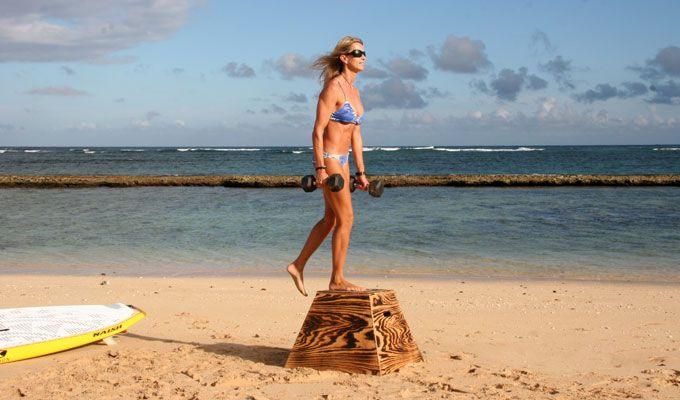
Stabilizing and Balance Workout
Stand up paddling on flat water, waves or riding a board like the 14′ Glide and catching a 50 yard glide, requires your legs to be strong together and independently.
I’ve written articles before on leg strength, but I want to get really specific here for stand up paddling. These exercises are designed to demonstrate techniques to use your own body instead of machines to achieve your goals, allowing your body to become the machine and your arms and legs to be powerful and stay in control.
Over the course of a few weeks, I’ll be sharing with you lots of excellent leg exercises that will help you catch more waves, dig your rails a little harder for a faster buoy turn and introduce you ways to combine leg strength, power and balance into your personal training so you can be a better paddler. There are four main types of leg exercises I’ll be showing you: Stabilizing/Balance, Strength, Balance/Strength and Power.
From small waves to big, connecting one glide to the next to casual paddling, I’ll attempt to break it down so you can learn about the fine stabilizing muscles around your ankles, knees and hips to the power house of your legs: the glutes. This year, you’ll be paddling stronger than ever!
This Week: Stabilizing and Balance Exercises
These exercises help promote quick reaction times, foot and leg stabilization to recruit finite muscles around your feet, ankles, knees, inner thighs, and the muscles that grab the ball of your femur or hip.
Exercise 1: Half Foam Roll Balance to Single or Two Legged Squat
Equipment:
12″ half foam roll
Dumbbells or medicine ball
Progression Variables:
Ground to 1/2 foam roll; add weight; add weight to front of body; move balancing leg forward, side, or back; perform squat
Click on the photo for a larger view.Balance on one leg while keeping your knee tracking over your long, 2nd toe. Look up, not down and keep your upper body as quiet and relaxed as possible. Squat down if you like and move your leg in the frontal plane or in front of you, back to the start position then move to the sagital plane or to the side of you. Keep foot and toes relaxed too. Progress this by adding weights in each hand or hold a medicine ball or dumb bell in front of you.
Then, flip the half foam roll horizontal and hop on with 2 feet, ALWAYS keeping your knees softly bent. If you stand straight up, just like on your SUP board, you’re goin’ down! Attempt some squats to be sure that your knees are again tracking over your 2nd toe. Add weight to progress.
Exercise 2: Stability Ball Knee Balancing
Equipment:
Stability ball
Progression Variables:
Close eyes; hold weight; standing
This exercise helps strengthen the inner adductors or thigh muscles, but also requires the hips to join in too. This is one of my favorite exercises and the bonus is, you work your core as well! If you’ve never done this before, please use a sturdy stationary object to assist you at first. If your ball is heavily inflated, it will be faster and less stable. Put less air in the ball to make it easier and more stable.
Mount the ball with your knees hip width apart and abs contracted. Find an object to focus on and slowly try to unhook your feet behind you from the ball so that it’s just your knees on the ball. Slowly get really centered and keep your upper body quiet. Time yourself for 30 seconds or more!
Stay tuned next week for a Strength exercise for those SUP legs!



